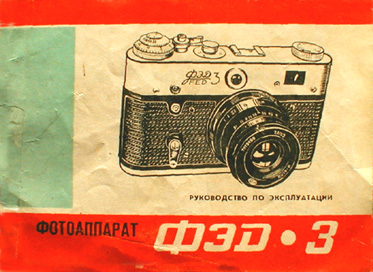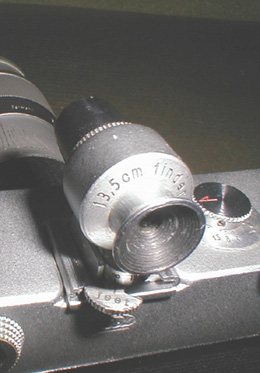Russian Leica Copies
Ivor Matanle, the author of that delightful book, "Collecting and Using Classic Cameras" , notes that it is harder, takes longer, and the results are no better, so why do it? A good question, for look at the process for getting an image with a modern SLR, available at moderate prices at discount houses everywhere:
- Place film cartridge in film compartment. Film will be automatically fed onto the takeup roll.
- Point camera at desired object.
- Compose image in viewfinder with power zoom.
- Push shutter button.
The camera will have already determined film speed by DX encoding. Exposure is automatic. Film is advanced automatically. Film will be rewound automatically.
Now lets look at getting the same image with an early Fed, a Leica screwmount copy:
1 - 10. Load film. This requires its own website.
11. Set film speed on meter (hand held or accessory shoe mounted).
12. Define object to be photographed.
13. Determine desired lens focal length. Mount same.
14. Get meter reading.
15. Select f stop and shutter speed based on meter.
16. Focus through rangefinder. This requires a fair amount of available light as these are not very bright.
17. Compose shot through accessory viewfinder. Remember to correct for paralax.
18. Check meter again in case light has changed.
19. Push shutter button.
20. Wind film.
21. Since the meter is unreliable, bracket shots both ways.
|
 FED 3 OWNERS MANUAL
FED 3 OWNERS MANUAL
IN CYRILLIC
|
Film must be advanced and rewound (a real pain) manually.
Note that the modern slr is lighter, has zoom lenses, usually a built in flash, and has excellent optics.
So why bother? One might as well ask why drive an Austin Mini when Accords are so readily available. Or why listen to LPs when CDs are so cheap. You either love doing it or you do not. It is not a matter of right and wrong, but of taste. Well, maybe that is a bit disingenuous, there are other reasons for a man my age. Let's take another look at getting an image with the modern slr - the way I do it:

Wood Ducks - Camera, Fed 3 with Hektor 135
|
- Get out camera. Look for a control that looks familiar.
- Fail utterly. Go seek owners manual.
- Read manual for about an hour before realizing that only every fifth page is in English - the others are sequentially French, German, Italian, and Japanese.
- Determine that the reason the English pages are incomprehensible is they are an English translation of a Japanese translation of a Malay tribal dialect.
- Find how to select one mode that I can understand.
- Discover that the battery is dead.
- Go get Nikon F or Zorki.
|
Granted, if I had to teach my children photography from scratch today we would get the manual of a Canon Rebel and go from there. To teach someone what they need to know for purely manual photography is a lengthy, tedious process. But having already been through it myself, I really do not want to start over again on some computerized wonder.
Ok, then why not Leica or Contax? Let's dispose of this issue right away - I would like an M2 as much as the next person; its just a matter of money and priorities. Leica and Contax fans are legion, and they have plenty of websites, list servers, chat rooms, and discussion forums to prove it. I am not against this in any way; I just cannot afford it. And even if I could afford it I would have serious problems carrying around that kind of asset value. I enjoy the Russian copies because they are cheap enough to be almost disposable. "He who steals my Fed steals trash" is my motto. Well, maybe not trash, but not anything of significant monetary value.
Of course even those who love these old cameras have differing tastes. The list above which documents the difficulty in using an early Leica copy contains elements which I am personally unwilling to accept. I use a Fed 3 and Zorki 4, both common and readily available LTM (Leica Thread Mount) cameras with REMOVEABLE BACKS, making film loading a snap. And the Zorki has a terrific viewfinder - quite bright. But they have their quirks none the less, and some would insist on a Fed 4, with its built-in meter, or the Zorki 6, with its lever advance and wide base rangefinder. Others are willing to put up with the difficulties of a Fed 1 or Zorki 1 in all their idiosyncratic glory for the sake of the small size and delightful handling qualities.
Of course there is always the monetary aspect. A decent user Leica IIIf body will run $500-$700 as of this writing. Please do not email me about the one you got at a garage sale for $50. I was not there, and it will only make me feel bad. But that is only the beginning. A standard set of lenses - 35, 50, 90, and 135 mm will run about $2000. And you need viewfinders for all but the 50, or a single multifinder. As these pieces have collectors value, every scratch you put on them costs $50. On the other hand, Feds, Zorkis, Mirs, Kievs, and the like just beg to be used. Accidentally dent one? No problem - many come pre-dented from the factory! Paying full retail prices, a Fed 3, plus four lenses, and a turret multifinder, should come in at not more than $500, and the results will be limited only by your own ability.
|
Russian Leica copy users have the added advantage of not being purists. This is by definition, of course. Would you really want anything not from Leitz to contaminate your irreplaceable Leica IIIg? Of course not. But we of the LTM-copy world will use anything cost effective. For us is open the world of Jupiter and Industar Lenses, not to mention the secret pleasure of the 21mm Russar. We gladly mount a Steinheil where we can, and even a bargain Leica if chance throws one our way. For us is reserved the joy of mounting an Argus turret viewfinder found in a clearance box at the camera shop.
|
 Unknown Japanese 135 mm finder. Note paralax correction.
Unknown Japanese 135 mm finder. Note paralax correction.
|
Note that I am constantly referencing Russian camera users and not collectors. That is because proportionately few of us are purely collectors. This is in stark contrast to the huge numbers of Leica collectors who never mount an accessory or load a roll of film for fear of destroying the value of their investment. There are Russian camera collectors, to be sure, but I cannot say I understand them. The sheer beauty of a Zorki 2c has never been known to send anyone into raptures, nor has the engineering magnificence of a Fed 5 been a source of amazement and wonder. No, these are cameras that fill a niche, a world somewhere between pragmatism and nostalgia, a photographic Valhalla where we join the ghosts of long gone photographers to do battle once again with the sun, the shadows, and recalcitrant subjects, armed only with the technology of 1938 Kharkov.


